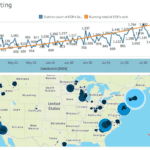August 11, 2020
After months in various stages of shut down due to COVID-19, many communities are eager to reopen their local economies. But the question of when and how to do so safely weighs heavily on public health authorities, particularly as the number of positive cases in the U.S. has now surged to more than 4 million, with positivity rates still above 5 percent in at least 31 states.
Across the OCHIN network to date, more than 23,000 presumed- or confirmed-positive COVID-19 cases have been recorded and our data continues to underscore the pandemic’s disproportionate toll on underserved communities—particularly Hispanic patients, who comprise about 36 percent of our network and more than 58 percent of its COVID-positive cases.
Public health departments need modern information technology (IT) tools, like electronic case reporting (eCR) that streamlines data sharing, in order to better understand where the virus is spreading, who is at greatest risk, and how to respond most effectively. A new project from OCHIN supports a national effort, called eCR Now, to lay the groundwork for a real-time virus tracker that can inform the allocation of scarce public health resources and help control community spread of COVID-19.
Built to a national scale and deployed in partnership with the Centers for Disease Control and Prevention (CDC), Association of Public Health Laboratories (APHL), the Council of State and Territorial Epidemiologists (CSTE), and other state and local public health agencies, eCR Now helps to close data reporting gaps and inform pandemic response. Through OCHIN alone, eCR Now has already delivered more than 115,000 reports to public health jurisdictions in 20 states, including both positive and presumptive-positive COVID cases. [Update: As of February 2, 2021, OCHIN has delivered 729,674 COVID reports to public health jurisdictions nationwide.]
Strengthening Public Health Infrastructure
Despite recent funding allocations to help modernize the country’s public health infrastructure in response to COVID-19, years of declining investment has hampered the ability of local health departments to upgrade and standardize their reporting systems. Today, many of these frontline disease trackers still rely on manually populated spreadsheets and antiquated paper, phone, and fax reports to keep tabs on the pandemic, which hinders timely and accurate reporting. And the lack of a centralized reporting system nationally makes it difficult to compare what’s happening across regions, leaving underserved communities, especially in rural areas, less prepared and less protected.
eCR Now helps fix these problems by improving the accuracy and efficiency of mandatory public health reporting, while reducing the burden on providers. When patients are tested for COVID-19, the results are recorded in their individual electronic health records (EHRs); from there, eCR Now automates the process of confidentially generating and transmitting validated case reports from the EHR system to public health agencies for review and action. This arms health authorities with real-time data about the virus’s spread and expedites contact tracing efforts and other support services to help patients quarantine.

Improving Health Equity with Real-Time Data
Since eCR Now first launched in mid-April, a number of states’ public health agencies have shared that eCR provides more timely, more accurate, and more detailed clinical and demographic information than current Electronic Laboratory Reports (ELR) and manual reporting options provide.
Agencies have reported that they are receiving eCR reports earlier than they do from some laboratory vendors, which has helped to accelerate reporting and contact tracing in several pandemic hot spots. Additionally, because it is integrated with the rest of a patient’s EHR, eCR Now gives public health authorities a more complete picture of the pandemic in relation to other important factors like racial/ethnic demographics, housing status, and comorbidities or chronic conditions. This allows for a better understanding of the effect of COVID-19 on medically complex and historically underserved patients. It also helps quantify the pandemic’s disproportionate effect on diverse communities and increases transparency by enabling aggregate anonymous race and ethnicity data to be shared with policymakers, reporters, and researchers nationwide.
Advancing Long-Term Interoperability
While OCHIN’s initial phase of eCR Now support was implemented in just three days as a direct response the COVID-19 pandemic, its full potential lies in enabling the CDC to establish a scalable nationwide framework to support standardized public health reporting moving forward.
According to CDC, there are an average of 100 diseases and conditions that are reportable to any given public health jurisdiction. These range from infectious diseases (like COVID-19) to foodborne illnesses (like E. coli) and other non-infectious conditions. By leveraging existing Health Level Seven (HL7) standards for the delivery of case reports, eCR Now brings a scalable national standard to required public health reporting and notifies medical providers once they’ve completed their legal reporting requirements successfully. It is compatible across several EHR platforms and can make use of existing transport options and legal frameworks, such as Direct Secure Messaging, eHealth Exchange, and Carequality. And the platform is being supported with free technical support and no-cost updates to accelerate COVID-19 reporting efforts by making it affordable and accessible to a wide range of clinics.
“The timely exchange of accurate and complete patient data between providers and public health agencies, which eCR Now enables, is imperative to understanding the spread of COVID-19 and informing plans to ease social distancing,” said Paul Matthews, Chief Technology Officer at OCHIN. “As a national provider of health technology solutions for underserved communities, we are thrilled to be part of this collaborative effort to modernize our country’s public health system for the future.”













